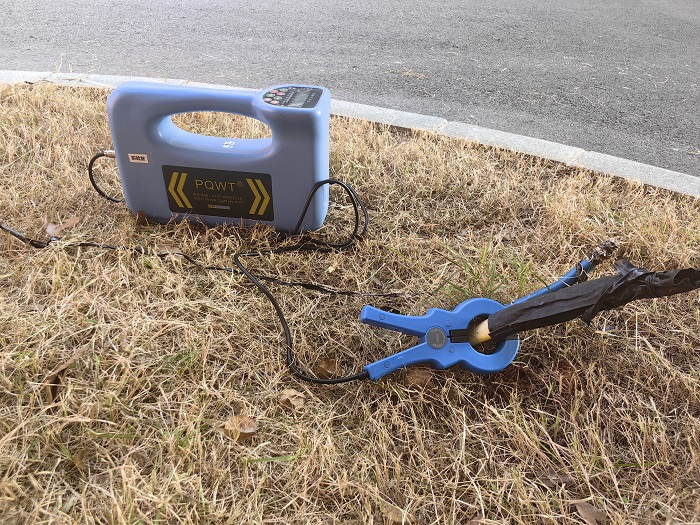In the field of underground pipeline detection, accurately and efficiently locating the position of pipelines and their depths is the key to ensuring the stable operation of urban infrastructure. However, in practice, Pipe Cable Locator often encounters various challenges, such as interfering signals, inaccurate depth measurement and other problems. This paper will provide detailed analysis and solutions to these common problems.

1. How does interference occur during the detection process?
The Pipe Cable Locator locates a pipeline by detecting the electromagnetic field generated by the signal current on the target pipeline. Ideally, the electromagnetic field is distributed in standard concentric circles. However, in real-world environments, signals on the target line are often coupled to neighboring lines, creating a "mutual inductance" phenomenon that distorts the shape of the electromagnetic field, resulting in interference. The severity of the interference is directly proportional to the frequency of the electromagnetic field, the higher the frequency, the greater the interference.
Solution: Use the direct connection method to apply the signal, and minimize the output power of the transmitter to reduce the signal coupled to other pipelines. At the same time, choose a lower frequency for detection to reduce interference.
2. Why are interfering signals detected on other pipelines?
Signals coupled to other pipelines through common grounding points or mutual inductance are the main cause of interfering signals detected on other pipelines.
Solution: Confirm that the signal is applied using the direct connection method and check that all connections are properly grounded. In addition, reducing the output power of the transmitter and selecting a lower frequency can also be effective in reducing interference.
3. How can I verify the accuracy of the Peak method of localization using the Valley method?
In an ideal interference-free environment, the peak and zero positioning positions should coincide. However, in the case of accompanying pipelines or interference, the two positions may not coincide. In this case, it is necessary to correct according to the distance between the peak and zero value position, the real position of the pipeline is located on the side of the peak, half of the distance from the peak/zero position of the peak point.
Solution: When the peak/zero value position does not overlap, take the extension line method to locate, and try to avoid pipeline inflection points, tees, variable depth points and other complex areas.
4. Methods to reduce the deformation of electromagnetic field pattern of pipeline
Reducing the output power of transmitter, changing to direct connection method or clamp method to apply signal, and avoiding the detection in the dense pipeline area are all effective methods to reduce the deformation of pipeline electromagnetic field pattern.
Solution: Flexibly choose the signal application method according to the site conditions, and pay attention to the changes in the electromagnetic field morphology, and timely adjust the detection strategy.
5. Can the equipment detect copper cables and fiber optic cables at the same time?
The current Pipe Cable Locator is mainly applicable to cables with metal sheaths or cores. For fiber optic cables, only cables with a metal jacket or a central metal reinforcing core can be detected.
Solution: Choose the appropriate detection method according to the specific type of fiber optic cable. For non-metallic fiber optic cables, you can consider using ground-penetrating radar and other advanced equipment for detection.
6. Receiver depth inaccuracy reasons and solutions
The inaccuracy of depth measurement may be caused by the inconsistency of positioning position between peak method and valley value method, soil moisture, detection signal frequency and other factors.
Solution: Firstly, check whether the positioning position of the peak method and the valley value method are consistent, and make corrections when they are inconsistent. Secondly, correct the direct reading depth and consider the influence of soil humidity and detection signal frequency. Finally, ensure that the receiver coil is perpendicular to the pipeline alignment to obtain the most accurate depth measurement results.
7. Maximum distance for signal tracking fiber optic cable
The transmission distance of the signal is usually 80 kilometers when the metal sheath is continuous and has not been short-circuited to ground. However, the actual detection distance is also affected by receiver performance and other factors.
Solution: Choose a receiver with superior performance for detection, and pay attention to the changes in signal strength during the detection process, and adjust the detection strategy in time.
8. Reasons for and responses to the sudden weakening of signal strength
Sudden weakening of signal strength may be caused by the pipeline changing direction, passing through T-shaped bifurcation or branch pipe.
Solution: Stop advancing and check whether the current measurement value remains unchanged. If the current value decreases, perform a 360-degree scan of the area to locate other centerlines and verify that the conductor is not branching. Also, check the pipe for damage or poor grounding.
In summary, the Pipe Cable Locator encounters a variety of challenges and problems in practical applications. However, through reasonable








